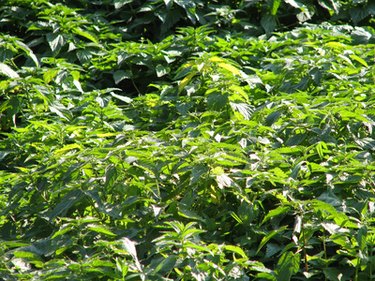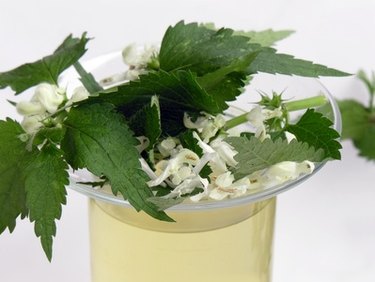
Considered both a weed and a wildflower, bull nettle--also often called stinging nettle-- has been resistant to most types of pasture herbicides. But development of a new type of herbicide in 2006 proved effective in killing the flowering weed known for its stinging hairs. It also is known as Texas bull nettle and is one of several types of stinging nettle plants in the Euphorbiaceae family.
Characteristics
Video of the Day

Bull nettle, also known as Texas bull nettle, thrives in the hot, dry grasslands of Texas, Oklahoma, Nebraska, Arkansas and Louisiana, according to the U.S. Department of Agriculture. It is known mainly for the skin-irritating and stinging qualities of the fine hairs that cover its leaves.
Video of the Day
The plant grows to about 3 feet in height with several stems growing out of the same root, allowing it to thrive in hot environments, according to the Lady Bird Johnson Wildflower Center in Texas. Its 2- to 4-inch long leaves look crinkled and are covered with stinging hairs. Bull nettle flowers are white and cover a thick almond-shaped seedpod that's also covered with stinging hairs.
Control
The Samuel Roberts Nobel Foundation recommends using brush-control herbicides in the late spring and early summer when the soil is wet to kill bull nettle, horse nettle and other weeds that can take over pastures by pushing out native grasses.
Oklahoma State University studies have shown effectiveness against bull nettle when the herbicides Remedy and PastureGard are applied in June or early July.
Timing
Herbicides should be sprayed on bull nettle when the plants are in bloom, according to the Samuel Roberts Nobel Foundation and Dow AgroSciences. When the plants are in the bloom stage in spring or early summer, they move high concentrations of the herbicide down to the roots, killing the entire plant and preventing regrowth the following year.
New Development
Dow AgroSciences developed a new herbicide in 2006 and marketed it under the name of Milestone, according to the University of Missouri Integrated Pest and Crop Management Newsletter: The product contained a new ingredient—aminopyralid—which stops the growth cycle of leafy plants.
The new herbicide was particularly effective on annual broad-leaved plants, but also worked well on perennials like bull nettle, according to the University of Missouri newsletter.
Considerations
Milestone usage does not require a pesticide license nor does it require any grazing or hay-making restrictions after usage, according to the University of Missouri. It should only be applied once per year.
Dow AgroSciences recommends that those applying the herbicide wear coveralls and chemical-resistant gloves and that workers should not enter a treated area for 12 hours following application. Milestone should be applied only when the potential for the chemical to drift to areas where people live or play is minimal.